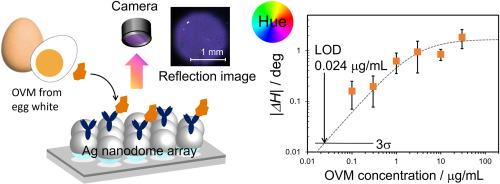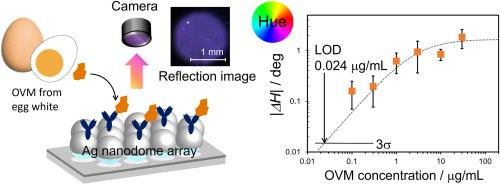Spectrometer-free plasmonic biosensor for rapid detection of egg allergen ovomucoid
IF 6
2区 化学
Q1 CHEMISTRY, ANALYTICAL
引用次数: 0
Abstract
Background
Food allergies are immune-mediated disorders triggered by specific food proteins, with symptoms ranging from mild to severe. Prevalence is increasing globally, particularly in children, prompting regulatory measures such as allergen labeling. However, accidental exposure remains a concern, especially in processed foods. Although biosensors offer promising on-site detection capabilities, their range remains limited. Ovomucoid (OVM), the dominant and highly antigenic egg allergen, is underrepresented in biosensing studies despite its clinical significance, highlighting the need for targeted development.
Results
We developed a spectrometer-free, colorimetric plasmonic biosensor for the direct detection of ovomucoid (OVM), the primary allergen in egg allergy. The sensor employs silver nanodome arrays that exhibit plasmonic color shifts upon target binding, quantified by changes in color space coordinates. A direct immunoassay enabled the detection of OVM within a concentration range of several to several tens of μg/mL, which corresponds to levels known to induce allergic reactions. The detection limit was determined to be 0.024 μg/mL. High selectivity for OVM was confirmed, with no significant response to non-target proteins. Additionally, the sensor produced clear signals from egg white powder, demonstrating its applicability to real food samples. Finally, a proof-of-concept demonstration of OVM detection in a food matrix was achieved.
Significance
This study introduces a compact, spectrometer-free plasmonic biosensor integrating metasurfaces, antifouling chemistry, and simple imaging for sensitive, label-free detection of food allergens. Its scalability, ease of use, and compatibility with smartphone-based analysis highlight its potential for on-site applications and pave the way for self-used food allergen testing.


无光谱等离子体生物传感器快速检测鸡蛋过敏原卵黏液样
食物过敏是由特定食物蛋白质引发的免疫介导的疾病,症状从轻微到严重不等。在全球范围内,特别是儿童中,患病率正在上升,促使采取诸如过敏原标签等监管措施。然而,意外接触仍然是一个问题,特别是在加工食品中。虽然生物传感器提供了很有前途的现场检测能力,但它们的范围仍然有限。卵黏液样蛋白(OVM)是一种主要的高抗原性鸡蛋过敏原,尽管具有临床意义,但在生物传感研究中代表性不足,突出了有针对性开发的必要性。结果研制了一种无光谱比色等离子体生物传感器,可直接检测鸡蛋过敏的主要过敏原卵黏液样蛋白(OVM)。传感器采用银纳米阵列,在目标结合时表现出等离子体的颜色变化,通过颜色空间坐标的变化来量化。通过直接免疫测定,可以在几到几十μg/mL的浓度范围内检测到OVM,这与已知的引起过敏反应的水平相对应。检出限为0.024 μg/mL。证实了OVM的高选择性,对非靶蛋白无显著反应。此外,该传感器从蛋清粉末中产生清晰的信号,证明了其对真实食品样品的适用性。最后,在食品矩阵中实现了OVM检测的概念验证演示。本研究介绍了一种紧凑、无光谱仪的等离子体生物传感器,集成了超表面、防污化学和简单成像,用于灵敏、无标签的食物过敏原检测。它的可扩展性、易用性以及与基于智能手机的分析的兼容性突出了它在现场应用的潜力,并为自用食品过敏原测试铺平了道路。
本文章由计算机程序翻译,如有差异,请以英文原文为准。
求助全文
约1分钟内获得全文
求助全文
来源期刊

Analytica Chimica Acta
化学-分析化学
CiteScore
10.40
自引率
6.50%
发文量
1081
审稿时长
38 days
期刊介绍:
Analytica Chimica Acta has an open access mirror journal Analytica Chimica Acta: X, sharing the same aims and scope, editorial team, submission system and rigorous peer review.
Analytica Chimica Acta provides a forum for the rapid publication of original research, and critical, comprehensive reviews dealing with all aspects of fundamental and applied modern analytical chemistry. The journal welcomes the submission of research papers which report studies concerning the development of new and significant analytical methodologies. In determining the suitability of submitted articles for publication, particular scrutiny will be placed on the degree of novelty and impact of the research and the extent to which it adds to the existing body of knowledge in analytical chemistry.
 求助内容:
求助内容: 应助结果提醒方式:
应助结果提醒方式:


